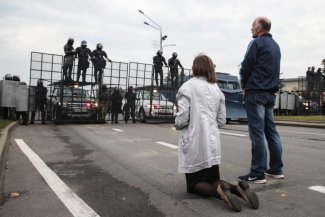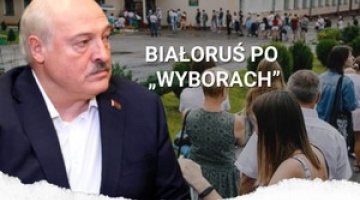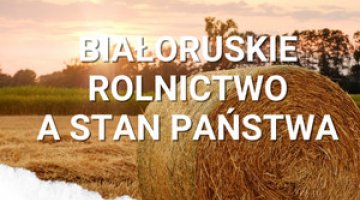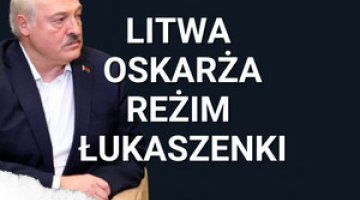Still unresolved: Belarus after two weeks of protests

On 23 August massive crowds of demonstrators took to the streets in the centre of Minsk to protest against the regime under the slogan ‘New Belarus March’. Between 100,000 and 150,000 people took part in the protest, as was the case on the previous Sunday. Regardless of the huge scale, the rally was peaceful. Its goal was to show the strength of opposition to Alyaksandr Lukashenka’s regime and to mobilise supporters of change to continue the protests. Demonstrations also took place in several other cities; the most numerous were seen in Hrodna, Brest and Babruysk. Members of the opposition coordination council took part in the march, including the former diplomat and minister for Culture, Pavel Latushka, who appealed to Belarusian MPs to back the idea of repeating the election (pursuant to the constitution, scheduling the election is the parliament’s prerogative).
Over the past few days, the government has been intensifying the pressure on the employees of state-owned companies who are on strike. Individual protest leaders (for example, at Minsk Tractor Works, MTZ) have been summoned for interrogations or detained (at Belaruskali, a plant producing potassium fertilisers). This further demobilises the workers who have been threatened that they will be dismissed and fined. As a result, it has been impossible to begin a full strike and fully cease production in any of the factories. Sviatlana Tsikhanouskaya, Lukashenka’s main rival in the presidential election, who is currently in Lithuania, appealed to workers to continue the strikes in a special statement on 21 August.
Lukashenka is continuing his propaganda counteroffensive, as part of which he visited Hrodna on 22 August. At a rally of his supporters he promised to bring back peace and security all over the country and once again accused his opponents of allegedly being anti-Russian and attempting to eliminate the use of the Russian language. During an inspection of military units near Hrodna he emphasised the need to maintain control of Hrodna region at any price since it was allegedly under the threat of NATO troops concentrating next to the state border and of internal destabilisation caused by the demonstrators’ intense activity. He also warned the West against any attempts to Belarus militarily, and announced that rebellious citizens would see a demonstration of force starting from Monday.
Lukashenka responded by strengthening his war rhetoric to the massive demonstration in Minsk on Sunday. Strong law enforcement troops (mainly OMON), with equipment at their disposal to disperse protesters, were seen for the first time in many days in Minsk. Regular army units appeared around the Great Patriotic War Museum. The minister of Defence, Viktar Khrenin, who was present there, warned the ‘fascistising’ demonstrators of the consequences of ‘desecrating’ this place. The greatest concentration of law enforcement forces was seen around the Presidential Palace, towards which some of the protesters were heading in the evening. Lukashenka, wearing a bullet-proof vest and armed with a gun, arrived there by helicopter and thanked the units guarding him for their exemplary service. Regardless of this huge mobilisation, the law enforcement units did not use violence against the demonstrators and did not detain any of them.
Commentary
- The organisation of another massive demonstration is doubtlessly a success for the opposition and an indication that the mood for public protest is still at a high level. At the same time, the government still does not show any interest in opening dialogue, viewing the demonstrations solely as a threat to the state’s existence. It seems that neither the coordination council nor other protest leaders know how their intended goals could be implemented. Continuing the demonstrations in a peaceful form, which is safe for their participants, may only contribute to prolonging the political crisis in the country and will not cause the government to make any concessions. At the same time, the huge pressure that has been placed on the workers on strike over the past few days has resulted in weakening the strike movement at industrial plants. This means the gradual loss of an important instrument of pressure on the regime, i.e. the threat of general strike in the industry sector.
- Lukashenka’s visit to Hrodna, combined with the replacement of the governor and a military inspection, demonstrated his concern about the intensive protest activity in this region and the fact that the local government tends to be more ready to make concessions to the protesters than anywhere else (local Hrodna television broadcast the demonstrations for some time). Another important factor is the region’s location, close to the border. This has offered Lukashenka a pretext for supporting his claims concerning the military threat from NATO, which has been widely publicised for the past few days. It cannot be ruled out that he will make similar visits to other regions in order to discipline local government elites.
- The thesis that the opposition Coordination Council for the Peaceful Transfer of Power allegedly has an anti-Russian agenda (this has been being emphasised by the state propaganda over the past few days) and the Defence Minister’s statement suggesting that the demonstrators represent a ‘pro-fascist’ orientation, are intended at polarising the public and dividing it into more nationally-oriented democrats on one side and pro-Russian supporters of the regime on the other. The simple stereotypes which have nothing to do with reality which the government is using to back its official narrative will escalate public tensions even further and will make it more difficult to overcome the crisis.
- The unprecedented highlighting of military aspects in Lukashenka’s narrative in such an ostentatious manner proves that he is desperate to protect his power. It is also an attempt to strengthen his bond with the law enforcement sector, which is the main source of support for the faltering regime and possibly for the partly disoriented nomenklatura. These moves are aimed at intimidating the protest movement, though they might have also made the impression that Lukashenka himself feels hemmed in and is afraid. It is also worth noting that the regular army was used for the first time to intimidate the demonstrators. Even though violence has not been used against the participants of the march, it cannot be ruled out that harsher repressions will be used in the coming days. A wave of detentions of the most active protest leaders, including the presidium of the coordination council, may be expected.




